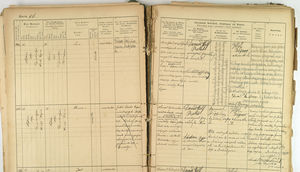Drohobych. Bruno Schulz is born.
The only known evidence of the birth of the fifth child in the family of Jakub Schulz* and Henrietta (Hendel) née Kuhmerker* is an official entry in the birth book of the Jewish register district in Drohobycz*.
From the note no. 265 on sheet 86, we may learn that a boy was born on July 12, 1892, who was given the name Bruno during the circumcision ceremony on 19 July 1892. The parents were “Jakub Schulz, a merchant living here” and “Hendel Kuhmerker, a wife who lives here only according to the Law of Moses, a merchant who lives here, daughter of the deceased local spouses – Berisch and Małka Kuhmerker, former owners of real estate”. Gittel Wegner assisted in childbirth.
In the light of the law in force in Galicia, Bruno Schulz is born as an illegitimate child. Jacob officially recognizes his paternity before the birth record clerk, which he did in the past after the birth of Isidore*. In the entry in the birth records of Bruno and Izydor, we may find a note that Jakub and Hendel Schulz entered into a legal marriage on 8 October 1892*.
Bruno Schulz is born as the last child of Henrietta and Jakub Schulz. The eldest of the siblings, Hanna*, was born on 27 November 1873, and brother Izydor was born on 4 September 1881. Bruno, however, had more siblings. Isaak Kuhmerker was born on 23 June 1876, and died on 29 October 1879 at the age of three years and four months. In the register of deaths, under the heading “disease and type of death”, difficilis was entered, which in Latin may mean difficult, unpleasant, complicated and rare. Hinda Kuhmerker was born on 2 October 1887. Bruno’s sister died of encephalitis on 22 May 1890, at the age of less than three, 12 two years before his birth. Isaak and Hinda bore their mother’s surname because Jakub Schulz did not officially recognize his paternity before the record clerk.
See also: 19 November 1942*. (mr, ts) (transl. ms)


